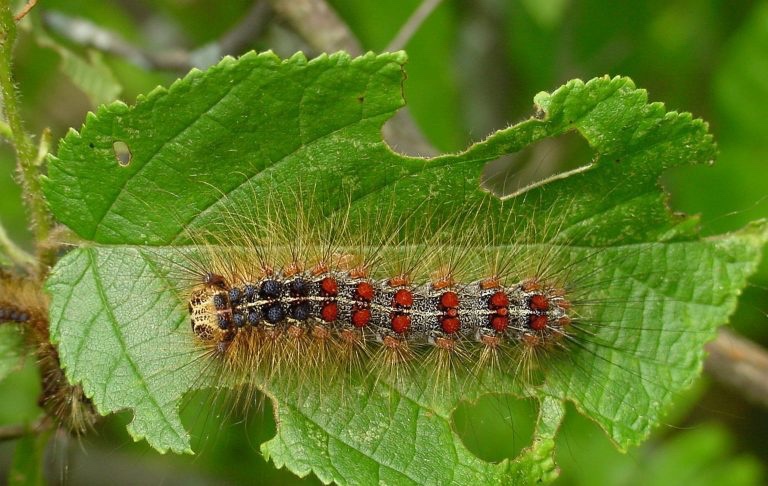Callan Small
Summer Intern
June 2017
My first day as a Mass Sierra Club intern threw me head first into a research project into the invasive Gypsy Moth insect that has infested Massachusetts for the past two summers.These annoying caterpillars have a hunger for oak, willow, apple, and other Massachusetts tree leaves. They have caused a lot of damage to our forests, and have even successfully killed a number of trees. While doing research, I was able to learn the history of this species, and methods to maintain their populations.
In the late 1860’s, Etienne Leopold Trouvelot brought the gypsy moth (Lymantria dispar) to Massachusetts from France in attempt to hybridize the species for silk production. Now almost 150 years later, the highly invasive species is haunting the Northeast more ferociously than ever. For the second year since the 1980s, the gypsy moth is predicted to consume over 100,000 acres of trees in over large expanses. Though the severity of the situation must not be taken lightly, it’s important to know that there are many steps homeowners can take to manage these invasive insects.
Why should we be worried? Not only because gypsy moths are nuisance that can cause itchy rashes, but because they are damaging forests throughout Massachusetts rapidly on a massive scale. The trees that the gypsy moths eat the most include various oaks, aspen, apple, and willows, all of which are common in the central and eastern parts of the state. As forest quality diminishes, so does natural habitat, biodiversity, air quality, soil stability, and overall enjoyment of natural spaces. Fortunately, there are many steps to take in order to manage gypsy moths.
Some insecticides may be used with caution when outbreaks have become uncontrollable. Bacillus thuringiensis is a common pesticide used for caterpillar control. It is considered to be a natural option that is safe to pollinators. It is important to apply the product later in the day, and in places where the caterpillars will be eating. It is better to use the product after the eggs have hatched but before the caterpillars become an inch-long.
Before starting this research, I knew nothing about gypsy moths, or the damage they could do. It started as simple as typing “gypsy moth” into google, and I was immediately amazed by how little people know about these insects. After doing research, I began crafting individual letters to the editor to the top newspapers in Massachusetts, spreading information about Gypsy Moths to readers. Though it was a topic most papers had covered, most of the articles neglected to mention how important tree vitality is to the nature of the commonwealth of Massachusetts. It was interesting to see which papers found the topic interesting enough to publish my letter, and wasn’t surprised that the Cape Cod Times was one of them. I’ve lived on the Cape my whole life, and have experienced gypsy moths in my own yard. They have killed trees on my parents property, and litter our garage, deck and cars. The Cape feels the presence of Gypsy Moth Caterpillars strongly, and it’s important for residents to know what they can do to monitor these pests. Overall, this project was stimulating in that I was researching a problem that I have dealt with. Below are the links to my published letters to the editor if you are interested in more information!
Cape Cod Times, June 16, 2017 "Gypsy moths chewing through Cape greenery"
Worcester, Massachusetts telegram.com, June 13, 2017 "Letter: Tree mortality a serious issue from gypsy moths"
South Coast Times, June 16, 2017 "Letter: Don’t ignore gypsy moths’ threat to trees"

Gypsy moth infestation potential trouble for New England
References
Boettner, Jeff, and Joe Elkinton. "Gypsy Moth Outbreak of 2016." Energy and Environmental Affairs. MassGov, 22 Nov. 2016. Web. 05 June 2017.
"Drought Management." Energy and Environmental Affairs. MassGov, 17 June 2013. Web. 05 June 2017.
"How to Use Bt Pesticide as an Organic Pest Control - Organic Gardening." Mother Earth News. Ogden Publications Inc., 07 May 2013. Web. 05 June 2017.
McManus, M., N. Schneeberger, R. Reardon, and G. Mason. "Gypsy Moth Outbreak of 2016." Forest Insect & Disease Leaflet 162. U.S. Department of Agriculture Forest Service, Oct. 1989. Web. 5 June 2017.
Marshall, Eliot. “The Summer of the Gypsy Moth.” Science, vol. 213, no. 4511, 1981, pp. 991–993. JSTOR, www.jstor.org/stable/1687050.
Tlumacki, John. "Yet Another Gypsy Moth Infestation Ahead..." BostonGlobe.com. The Boston Globe, 22 Jan. 2017. Web. 05 June 2017.